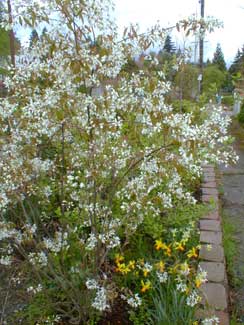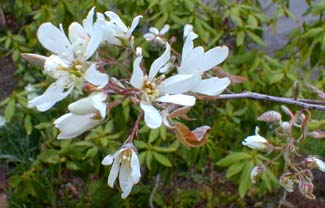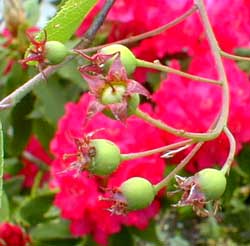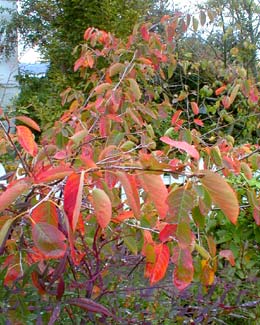
Shadblow or Shadbush Serviceberry
"Then there are shadblow & delicate anemones, about the time of the cherry blossoms; the brief glory of the apple orchards follows; & then the thronging dogwoods fill the forests with their radiance; & so flowers follow flowers until the springtime splendor closes with the laurel & the evanescent, honey-sweet locust bloom."
-Theodore Roosevelt,
1858-1919
1858-1919
The deciduous Shadblow Serviceberry (Amelanchier canadensis) is a common small tree or large shrub along the eastern seaboard of Canada & the United States. Its extensive range down the coastline stops before it reaches Florida.
 Besides Shadblow or Shadbush, it is also known as the Downy Sarvis, Canadian Serviceberry, Thicket Serviceberry, or Juneberry.
Besides Shadblow or Shadbush, it is also known as the Downy Sarvis, Canadian Serviceberry, Thicket Serviceberry, or Juneberry.It is usually spotted in damp or boggy areas, but in gardens it tolerates normal moist well-draining soil, not demanding too much water. When well-established it does not need more than average watering & a few droughty days won't hurt it, even though it is never fond of protracted outright dryness.
 Ours is positioned in a sunny sidewalk garden next to a Black Twinberry & a couple of large ironclad rhododendrons, for a mixed texture of evergreen & deciduous shrubs.
Ours is positioned in a sunny sidewalk garden next to a Black Twinberry & a couple of large ironclad rhododendrons, for a mixed texture of evergreen & deciduous shrubs.Though trainable as a single-trunked tree, it is naturally a multi-trunked suckering shrub. Vase-shaped, or upright with moderate fountaining, it can grow to 25 or 30 feet in the wild, but in garden conditions, it rarely exeeds 15 to 20 feet, & is easily kept pruned to 10 or 15 feet.
Slightly fragrant, showy flowers have five thin white petals & a creamy yellow center. These half-inch flowers occur in small clusters or upright racemes, from late March to early May, but mainly from about mid-March to mid-April.
Hints of the blooms are peeping out of the buds as early as the first week in March. When in two to three weeks it is in fullest flower, it also begins to leaf out. The flowers are most stunning before the leaves compete for attention, a veritable cloud of small blossoms all over the branches. Day by day, the leaves get larger amidst the blooming branches.
 Flowers turn into green berries, as shown in the second photo snapped in May, backed by the bright red blooms of a nearby Jean Marie Rhododendron. These slowly turn deep pink or red, then ripen to purple-black by June or July, hence the alternate name Juneberry.
Flowers turn into green berries, as shown in the second photo snapped in May, backed by the bright red blooms of a nearby Jean Marie Rhododendron. These slowly turn deep pink or red, then ripen to purple-black by June or July, hence the alternate name Juneberry.They are sweet & tasty raw & very useful for jams & pies, if birds don't beat you to them. Birds like them so much that netting will be required before the fruit is fully ripe, or just resign yourself to getting fewer of them than the birds. For more fruit photos, see the Serviceberry page of the Pomes & Berries Gallery.
Its autumn display of red, orange & gold is very appealing, as can be seen in the late October photo at right. Additional autumn leaf portraits can be seen on the Serviceberry page of the Autumn Leaves Gallery.). Shadblow serviceberry can be a good substitute for the smokebush (Cotinus coggygria) which is over-utilized here in the Northwest, though it must be admitted that colorful serviceberry leaves do not remain so long on branches once they have changed.
After leaf-fall, the upright branches continue to provide winter appeal. The bark is smooth in the shrub's youth, silvery grey with darker stripes. As it ages, the bark splits into craggy furrows with increasing character.
Shadblow Serviceberry is extremely cold-hardy & does well in full sun to partial shade, with medium moisture. If there are poorly draining areas where most shrubs would be at risk of root-rot, Shadblow Serviceberry can be most useful, but such bogginess is not essential & it also does fine in ground with normal watering schedules. For a droughtier situation, however, the Western or Saskatoon Serviceberry (Amelanchier alnifolia) would be a better choice.